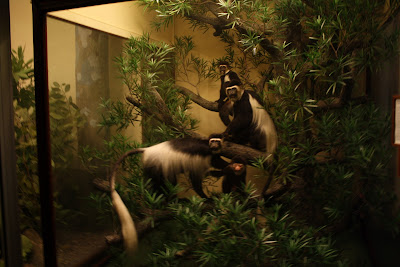Last week I drove down to Bradenton to visit the South Florida Museum--which also houses the Parker Manatee Aquarium and the Bishop Planetarium. I was excited about the visit, which I'd been meaning to do for a long time, but I was also super-excited because I made it there in time for Snooty's 1pm feeding, and I am a huge sucker for manatees. [ed note: do not mock! They are most closely related to elephants, they feel like a wet football when you touch them, they have no natural predators, and they can eat a head of romaine lettuce in one gulp. Pretty much the best sea mammal out there.]
While I was there for the manatee aquarium, I was also excited to see the rest of the museum's collections, which are pretty eclectic. So I paid my admission and walked into the main hall, where I was excited to see a huge replica mastodon skeleton dominating the room, with a nice diorama of hunters and bison in the background. It was a really nice first impression of the museum, but it didn't last all the way through. I really loved the feel of that first hall, but my impression of the rest of the museum isn't quite as favorable.
 |
| Okay, dioramas are cool, and giant shark jaws are cool, but they just don't quite go together... |
I think my issue with the the South Florida Museum was not its collections, nor the way they were displayed. I think what was lacking was a sense of cohesion. As you stepped from one hall to the next, there didn't seem to be a rhyme or reason as to what came next, and there was no obvious path through the exhibits that would allow a visitor to see everything easily. Okay, to be fair, the map they handed me with my ticket has a suggested route, but I don't think it was very intuitive. At one point you walk past the gallery of first peoples' artifact through a door that looks like an exit in a courtyard that was, at the time of my visit, completely deserted. The courtyard is the home of Snooty's underwater viewing tank, though, so I had a good few minutes watching the manatees--and then realized I was late for the feeding and ran upstairs to catch the remainder of the manatee talk. This left me upstairs in a kind of mishmash of galleries--a river diorama, drawers of random portions of the collections (cleverly labeled "Visible Storage," which I quite liked), and then through an interesting series of galleries with old medical equipment. I completely missed the 1500s Spanish House and Chapel, largely because I thought they were storage spaces when I saw them outside in the abandoned courtyard. I wish there had been some clearer signage alerting visitors what was through those doors.
And you know, this visit made me realize how totally subjective museums are. Because the South Florida Museum isn't really doing anything wrong. Their collections are a mishmash because they're a relatively small facility and had most of their exhibits donated. So while giant shark jaws and old ether bottles don't really go together, no museum is going to say "No" to a donation of either one. And you know, if I'd followed the map they gave me instead of shoving it in my camera bag I would have seen more of the exhibits--but I would have missed learning that Snooty's favorite treat is apples, so there would have been a trade-off. I love the idea of putting a rotating display of random items from collections on display to the public, and I think that exhibit could have been really successful if there had been a bit more signage and a couple fewer artifacts--it was sort of overwhelming to look at everything in that big case and I found myself glossing over lots of it. it wasn't until I looked over my museum map to write this post that I even realized what the intent of that case was. But the idea of that case is ingenious, and with some clearer labels it could really be the type of display that visitors get involved with.
In the end, I enjoyed myself at the South Florida Museum, for all that there were somethings that I would do differently. It was an interesting exercise to visit another small local museum of which I had no prior knowledge. There's not a lot they could do to change their collections or displays, and as a result the South Florida Museum is a good illustration of a lot of the challenges smaller museums face. (Perhaps more museums should house awesomely personable manatees? Just a thought...)
For me, this visit brings two issues into focus for me. The first is how museums can better communicate to their guests. This means communicating how best to see the collections, what to expect, and what events are going on that day. The second issue is labeling and text panels. I am a HUGE proponent of interpretive text that informs the visitor without talking down to them. Had there been a clear sign by the Visible Storage case explaining the purpose, and labels for each of the items, I would have spent my whole day there. It will be an interesting exercise to look at how these same issues play out in my own museum, and try to look at our displays from the perspective of a visitor who doesn't know what she's walking into.





























